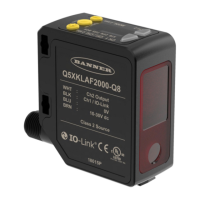• —0 = the front of the sensor or the maximum range, depending on the setting
This figure illustrates three examples of how changes to the zero and shift settings affect what distance readout is shown on
the display when in 2-pt TEACH mode. Changes to the zero setting affect the direction in which the distance increases.
Shifting the zero reference location only affects the readout on the display and does not affect the output.
Zero = Near
(Default Setting)
Shift = Off
=
=
Zero = Far
Shift = Off
=
=
Zero = Far
Shift = On
=
=
Display Reference Display Reference
50 cm
Display Reference Display Reference
Display Reference
Display Reference
cm
200
0
100
50
150
cm
200
0
100
50
150
cm
200
0
100
50
150
cm
200
0
100
50
150
cm
-50
150
50
100
0
cm
-50
150
50
100
0
50 cm
50 cm
Figure 18. Example Zero and Shift settings
3.2.11 Offset
Use this menu to set an offset from the taught surface during a TEACH procedure.. This menu is available only if one-point
window (foreground suppression) mode or one-point background suppression mode is selected. For Channel 2, the output
must be set to light operate or dark operate.
Note: The number that follows on the display indicates which channel is selected.
The offset is automatically calculated or manually defined as a consistently applied value. Auto is the default option. Use +/-
to select a value. Values increase or decrease by up to 191 cm (2000 mm models).
For BGS mode, the default is Auto because the Q5X automatically selects where to position the switch point. For FGS
mode, the default is 0 because the window is centered around the taught target.
A positive offset value always shifts the switch point location or the FGS window towards the sensor.
Q5X Laser Triangulation Sensor with Background Suppression
16 www.bannerengineering.com - Tel: +1.763.544.3164

